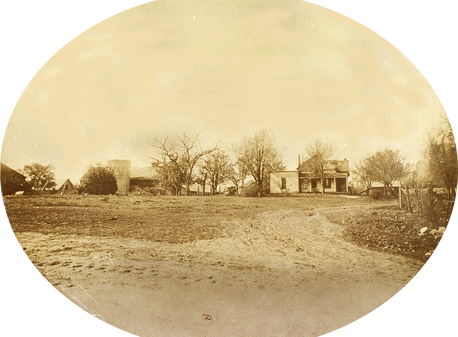 Slifsgaard farm, ca. 1880. Slifsgaard farm, ca. 1880. By ED ANDERSEN [email protected] My mother, Esther Thuesen Andersen, inherited one-fourth of the Slifsgaard farm in Fredsville, Iowa when her father, Erik Thuesen, died. Mother’s brother Jens was operating the farm when he died in 1936. His widow, Aunt Anna Thuesen, moved with her family to an apartment in Cedar Falls. During the depths of the Great Depression, my parents, Harold and Esther Andersen, took out a loan and bought out mother’s siblings to obtain sole ownership of the Slifsgaard farm in Fredsville just down the hill from the Fredsville Lutheran Church. My first memories were in 1941 of our project to tear down the old barn where during past years they milked 100 cows by hand and milkmaids lived in the big white farm house. This is the house in which we lived until 1950. Uncle George helped bring running water into the old house and install a bathroom with a tub, stool and washbasin, and water tank that was heated by the wood-fired cookstove in the kitchen. We had a dial telephone on a party line. During the winter, an oil-burning stove was brought into the dining room and served as an additional heating source besides the kitchen cookstove. 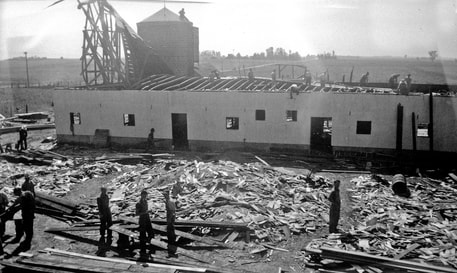 Taking the barn down. Taking the barn down. During 1941, we built a new barn to house the cows, steers, horses, and calves in large ninety-foot barn with a haymow to hold all that loose hay for the animals. The barn was almost finished when a windstorm tore it apart. Bedstefar N. L Andersen came out to the farm and supervised us three boys as we pulled nails to help and reuse lumber to rebuild the barn. The barn was completed and filled with hay and animals. The new barn stood one year and then on October 31, 1942, the barn with all its hay burned down. Dennis was able to get all the animals safely out of the fire. Fire crews and neighbors worked all night to keep our house and other building safe from the fire. As winter approached, we moved our milk cows to the barn of our neighbor, Arnold Mikkelsen. We hauled feed and milked the cows twice daily until the next barn could be completed. Early in 1943 we began the process of building a new barn to replace the big barn that had burned down with all our hay. Since the country was in the midst of World War II, goods were rationed. Permits to buy materials to replace destroyed structures were given, but the value could not exceed the price of the destroyed building. The new smaller barn had room for twelve milk cows with newborn calves and four horses. It was built to accommodate an electric cream separator and milking machine and the large haymow had room for loose hay. When the barn was completed in early June, my parents held a barn dance in the new haymow to thank all the friends and neighbors who had helped with the construction of three barns on our farm. We three boys served cold pop out of the stock tank. In 1944 we built the fourth barn to house our beef cattle. Permits were issued for $1000 of materials to buy cement, siding, and shingles. We cut down many cottonwood trees and had them cut into lumber and we tore down an old cedar wood stave silo for the ceiling timbers to hold up the hay. Witnessing the work of building barns, especially in the context of a global war, made a significant impression in my childhood. I saw what could be accomplished when folks pitch in to help.
0 Comments
April 18, 2021
By PASTOR ANDRÉS ALBERTSEN [email protected] It was May 25th of 2020. Darnella Frazier was only seventeen years old. She had been watching her nine-year-old cousin, who had insistently been asking for snacks from Cup Foods, the store at the corner of 38th Street and Chicago Avenue in South Minneapolis. It was only a few blocks away from the family apartment, and Darnella had walked there “hundreds, maybe thousands” of times. Around 7 p.m. Darnella decided that she would take her cousin to the store so that she could get the snacks she so badly had wanted the whole day. When they were about three storefronts away from the store, Darnella saw four officers roughly removing a black motorist from his vehicle. So, when they reached the store, Darnella told her cousin to go inside and find her snacks, while she stayed outside, pulled out her phone and began recording. She had already seen in her neighborhood a lot of what, in her estimation and in the estimation of her family and the members of her community, was police brutality, and she knew that officers rarely faced consequences. “It was like a natural instinct,” she said. “The world needed to see what I was seeing. Stuff like this happens in silence too many times.” By the time she started filming, the officers were already restraining the man on the ground. You may have watched the roughly nine-minute video, or at least parts of it. Miss Frazier posted it on Facebook and it immediately went viral and was watched hundreds of thousands of times all around the world. It is the video that shows former officer Derek Chauvin’s knee digging into George Floyd’s neck as the man begs for his life and then goes limp. The officer looks directly at the camera, expressionless, while bystanders and Darnella herself yell out in concern. Miss Frazier was utterly terrified when she was filming. She knew that she was as vulnerable as anyone. She knew that in any minute she could become a victim as well. She was scared for her safety and for her cousin’s safety, who had not stayed in the store and was now standing with her. But she was convinced that if she did not continue filming with a steady hand, no one would know what had happened. “Man dies of medical incident in police custody.” This is what the involved officers declared to the police department, and this is how the news at first was reported in the media. But Darnella Frazier’s video is why the four police officers were fired the day after George Floyd’s death. Her video is why those officers were charged with murder. Her video is why Derek Chauvin is standing trial right now, and why the other three officers will stand trial later this year. Darnella Frazier had no intention of stumbling upon any historical event that evening. She was a typical seventeen-year-old, going to high school, working her job, having her friends, and a boyfriend, not a community leader, just a regular person who happened to do an extraordinary thing. Police Chief Medaria Arradondo praised her action a few days after the event. While “we should never have to rely upon” witness video to keep police accountable, the chief said, “I am thankful, absolutely, that this was captured in the manner that it was.”1 “With nothing more than a cell phone and sheer guts, Darnella changed the course of history in this country, sparking a bold movement demanding an end to systemic anti-Black racism and violence at the hands of police. . . . With remarkable steadiness, Darnella carried out the expressive act of bearing witness, and allowing hundreds of millions around the world to see what she saw. Without Darnella’s presence of mind and readiness to risk her own safety and wellbeing, we may never have known the truth about George Floyd’s murder.” This is how PEN America, a nonprofit organization that promotes free expression, explained that they were distinguishing Darnella Frazier with the organization’s courage award.2 I don’t know about Darnella Frazier’s personal beliefs, but because she did the right thing, I consider that she was also a witness to Jesus Christ. I always carry my phone with me, and it has a camera. And I cannot stop asking myself what I would have done in that situation or in a similar situation. My honest answer is first that I have not witnessed police violence in the same way that Darnella Frazier and her community has. My honest answer is that I would probably have assumed that the police was doing the right thing. I am afraid that I would have walked faster and avoided the possibility of getting into trouble. And I ask myself, What is the privilege or the shortsightedness that exempts me from having to witness injustices that are recurrently faced by other people? What kind of Christian witness would I have been by assuming that the police was doing the right thing or by passing by? How can I say that I would have assumed that the police were doing the right thing when as late as last Sunday another black man, the twenty-year-old man and father to a one-year-old kid, Daunte Wright, was killed by a police officer during a Sunday traffic stop in Brooklyn Center in our own state of Minnesota, fifteen miles away from were George Floyd died? The truth about Easter and its proclamation in the earliest church is that it is not all about victory, wonder, and rejoicing. The stakes were high back then and they are also high today. Therefore, we are reading the story of Christianity’s first martyr, Stephen, already on the Second Sunday of Easter. Jesus certainly is Lord, but he was resisted in the earliest church and he is and will be resisted today.3 Darnella Frazier did not choose to get traumatized, she did not choose to have trouble sleeping, she did not choose to be in a situation in which she would close her yes and see it all over again, she did not choose to be in a situation in which she would stay up at night apologizing to George Floyd for not doing more and not physically interacting with the officers and not saving his life. In the moment she started filming, she did not care that she could expose herself to be harassed, as it in fact happened, by some who accused her of sharing the footage to get attention and by others who criticized her for not doing more. She just did the right thing. Even more so should Christians, who are resurrection people called to be there for others, do the right thing. But lo and behold, I just confessed that I would not have done what Darnella Frazier did, even when I always have a smart phone with camera with me. And this confirms how appropriate an Easter greeting published last Sunday by a friend of mine was. It was addressed to people who don’t see themselves as Christians, and my friend said, “If you don’t know what an Easter is, just know that there is hope. And those who believe in this hope (the real, hard kind) are sent into the hard places for the sake of love. Sometimes you must squint to see us [and I understand that she meant “to see us the Christians”]– however,” the greeting continued, “don’t give up on us. You [and remember that she is talking to those who don’t see themselves as Christians and those who are not vocal about their faith], you are usually the ones who show us the hope we believe in.”4 These are perfect words to describe Darnella Frazier. She has shown me the hope I believe in. It is mystery that doing the right thing can have adverse consequences. It is a mystery that Christians would not be protected by our Lord from the adverse consequences of doing the right thing. This was the question a student I had at St. Olaf College asked me. He was from China and my class was his first exposure to Christianity. We had been talking about the Salvadoran Archbishop Oscar Romero, who served in the last years of the 1970s, when civil war raged in El Salvador, and many died of hunger and many were killed for fighting against hunger. Oscar Romero himself ended being murdered while leading worship and becoming another martyr of Christianity in 1980. He argued that church leaders had to join the poor to speak out from the side of the poor against the injustices committed against them, and he anticipated that they would face persecution because of doing that. And here comes the most controversial part of Romero’s thought. Persecution was not only the sign that the church was being faithful to Jesus Christ, but also a sign that Jesus Christ was being faithful to his church. This is what brought my student to ask if Christ should not have shown his faithfulness to the church by protecting and saving its leaders and members from persecution. Not a crazy question at all. It is truly a mystery that Christians are not spared from persecution, suffering, and death. Two Sundays ago, on Easter Sunday, we reflected on the fact that resurrection was unexpected and difficult to believe. However, we would not have Christian faith nor a church unless resurrection had been believed and embraced. But once the followers of Jesus had accepted and believed in the resurrection, the New Testament authors saw it as their main task to bring Christians to understand the passion and death of the one whose resurrection they were celebrating and hoping to share. Not with the purpose of pointing them to the past, but rather, by means of their account of the passion of Jesus, to direct them to the present and future when this passion would have to be emulated. The members of the earliest church were not permitted to stand back gazing in admiration at the resurrection but were rather directed to the urgent demands of a witness that is faithful to Christ. And you and I are directed now and here to the demands of a witness that is faithful to Jesus Christ today5 It is not an option to ignore the injustices that are going on, nor to pass by them, nor to think that there is nothing I can do, and I say it first to myself. Resurrection is why we should get involved in the problems of others. Resurrection is why we should draw near to each other, even when it is uncomfortable. Resurrection is why we should continue to look bravely at the wounds of one another and trust that God can raise new life even out of death.6 Resurrection is the promise that also you and I will see Jesus, like Stephen did when he was being killed, that we will see Jesus as we bear witness to him, and as we fight with Darnella Frazier for a society that honors the equal dignity of all. Amen. Prayers: Dear Lord and God, We thank you for the witness to our Lord Jesus Christ by Christianity’s first martyr Stephan who was stoned to death by people who confessed themselves to be believers in God. We thank you for the witness in favor of the poor of martyr Archbishop Oscar Romero of El Salvador. We thank you for the witness in favor of the dignity and civil rights of our African American siblings by martyr Reverend Martin Luther King Junior whose assassination anniversary happened to be on Easter Sunday. We thank you for the witness in favor of all the victims of Nazism by the German pastor and theologian and martyr Dietrich Bonhoeffer whose assassination anniversary was on April the 9th. We thank you for the witness of Darnella Frazier who made us see injustices that many of us were not aware of because of privilege or shortsightedness. Help us not only to admire them, but also to follow their examples. We know that it is not right to love our martyrs while we loathe and despise our marchers.7 Help us to discern if we will join the marchers or how else we will support their fight. Free us from the fear and cowardice that can make us worry more about order than about justice.8 Dear Lord and God, make us mindful of the fact that we all have been through a year filled with death and grief, a year of disappointment and lost hope. We pray for the many among us who are still deep in their grief. For those who have lost a job, for those who have lost stability, for those struggling with mental health, depression, anxiety, eating disorders, and addiction. We pray for those who are grieving the loss of a loved one, for those who feel isolated and alone. We pray for all those who are suffering, remembering especially those we name now silently or aloud. We pray that you will guide us in coping with our suffering so that we do not fall into despair but turn our broken lives and our wounds into new and unexpected lives of deep empathy with others who are also suffering. Dear Lord and God, give us strength to face death with serenity and grace when time comes for that. In the meantime, teach us to appreciate your mercies and your faithfulness that are new every morning. Make us always welcome the love and attention of beloved and caregivers. Give us the confidence that you will be with us to the very end, and that you will bring us into the blessed rest of everlasting peace, and into the glorious company of the saints in light . All these things and whatever else you see that we need, grant us, dear Lord and God, for the sake of him who died and rose again, and now lives and reigns with you in the unity of the Holy Spirit, one God now and forever. Amen. 1. For all that comes before, see: “The Video That Sparked a Movement, “ CBS This Morning, posted June 15, 2020; "The Traumatized 17-Year-Old Who Filmed George Floyd's Death Is Already Being Harassed," by Ely Belle, Refinery29.com, last updated May 29, 2020; " 'World needed to see,' says woman who took video of man dying under officer's knee," by Chao Xiang and Paul Walsh, StarTribune, posted May 26, 2020; https://www.facebook.com/darnellareallprettymarie/posts/1670313089836457, posted Mar. 11, 2021; " 'When I Look at George Floyd, I Look at My Dad,' " by Angelina Chapin, The CUT, posted Mar. 30, 2021. 2. "PEN America to Honor Darnella Frazier, Young Woman Who Documented George Floyd's Murder," posted Oct. 27, 2020. 3. "Commentary on Acts 7:55-60," by Matt Skinner, Working Preacher, posted May 22, 2011. 4. Laura Aase on Facebook on 4.4.2021. 5. Ted W. Jennings, Jr., The Insurrection of the Crucified. The “Gospel of Mark” as Theological Manifesto, 303. 6. Pam Fickenscher, "Sermon for Second Sunday of Easter, Apr. 8, 2018," St. John's Lutheran Church, Northfield, MN. 7. "How Dr. King Lived Is Why He Died," by Jesse Jackson, New York Times, posted Apr. 3, 2018. 8. "Letter from a Birmingham Jail," by Martin Luther King, Jr., Apr. 16, 1963. Highlights of the May, 2021 Issue
Known for his talent as keyboardist, Glenn Henriksen shows in the cover photo that he also has an eye for photography. The opening song is to a tune for hymns no 461 and 771 in the current ELCA hymnal. Other denominations in the U.S. may know it as “Brethren, We Have Met to Worship,” which starts in a similar vein as the text written by Joyce Marshall. She is on the faculty of Realistic Living (http://realisticliving.org/index.htm), an organization whose mission is to “clarify the essential Christian heritage and to promote and inspire its practice through small groups.” These lyrics by Joyce were taken from Songs of Resurgence, which she compiled in 1999 for use in such small groups. Though the sermon by Andrés Albertsen is based on the readings from the second Sunday after Easter, it is especially appropriate as we approach the first anniversary of George Floyd’s death on May 25. He reminds us of the hope in which we believe. In the mode of reflecting on what was happening a year ago at this time, the final installment of “The Slow Spring of the Reaaranged Rest of Our Lives”by Erik S. Hansen takes us through the last month of his stay at the lake house where he was caught at the outbreak of the pandemic. Observing the activity of nesting birds gives rise to his own considerations of settling down. We hear from Hanna Broadbridge about the threat to family cohesion of asylees who have made Denmark their new home after fleeing danger in their home countries. With the backdrop of World War II, Ed Andersen shares his boyhood experience of building barns. The Iowa Barn Foundation holds tours of such historic barns and included last year a barn on the farm still in the family of Ole Johnson one of the original Fredsville settlers. Announcements You are invited to celebrate Grundlovsdag, June 5, 2021, by attending the online conference of the Danish American Heritage Society (DAHS). The theme is “Traditions and Transitions: Ways of Being Danish.” Running from 9:30 a.m. to 4:00 p.m. (Central Time Zone, that is, UTC - 05:00), it will be a full day of virtual learning, entertainment, and interaction. Registration is $30.00 or free with a general membership of $30.00. Both registration and membership activation/renewal can be done on the conference page of the DAHS website, https://conference.danishheritage.org. West Denmark Family Camp will not be in person this year but will send information to regular camp attenders about an online bulletin board to share updates and activities people are doing at home. Likewise, the June and July Danebod Family Camps will not be in-person, but virtual alternatives are being explored. Regulars will be receiving email updates. Former Church and Life editor, our beloved Joy Ibsen, is pleased to announce the release of the second edition of Here and Hereafter: The Eternity Connection. Joy has this to say about it: “Spiritual legacy is perhaps the most significant aspect of this book. When I look back at the family into which I was born, I remember the stories of a spiritual nature that deeply affected the very core of our being. We did not talk much about them but we knew them. Those powerful stories about death and new life could pull us through any challenge, any heartbreak, any doubt.” The first edition of this collection of short stories received five-star reviews, so this newer “cleaned up” edition is surely a work worthy of gifting yourself and family. It is available on amazon.com in paperback and Kindle format. Another book that will be of interest is the soon-to-be-published Volume 5 of the six volume series of Grundtvig’s writings translated into English and published by Arhus University Press. Edward Broadbridge will surely produce yet another remarkable anthology of translations with this upcoming volume: The Core of Learning: N.F.S. Grundtvig’s Philosophical Writings. |
Editor InformationBridget Lois Jensen Archives
March 2023
|
Subscribe | Gift |
Submit an Article |
Contact |
© COPYRIGHT 2019 CHURCH AND LIFE.
|
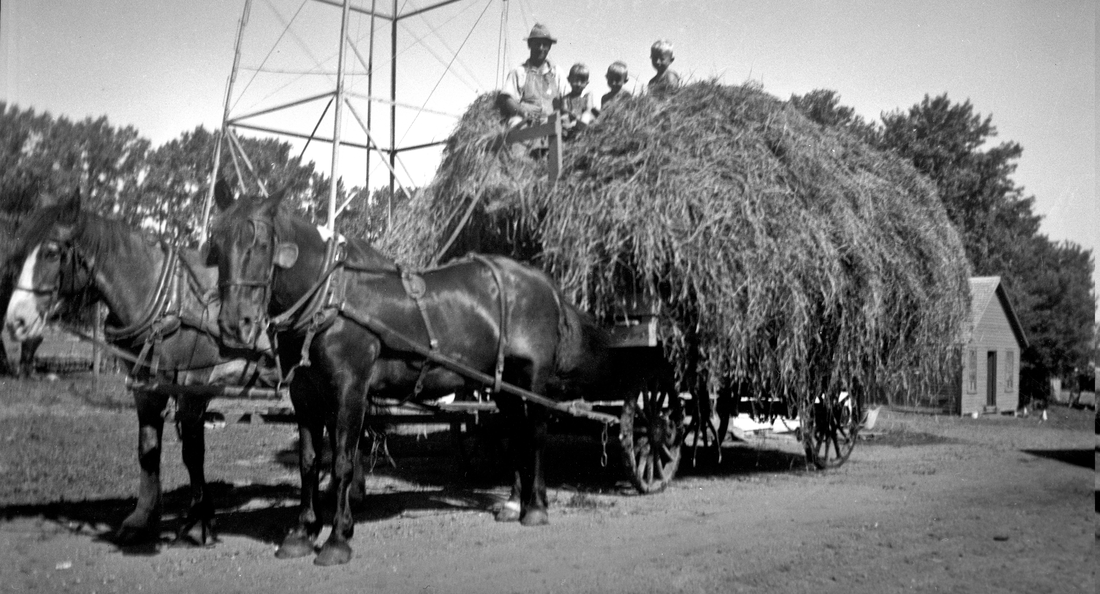
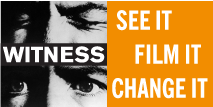
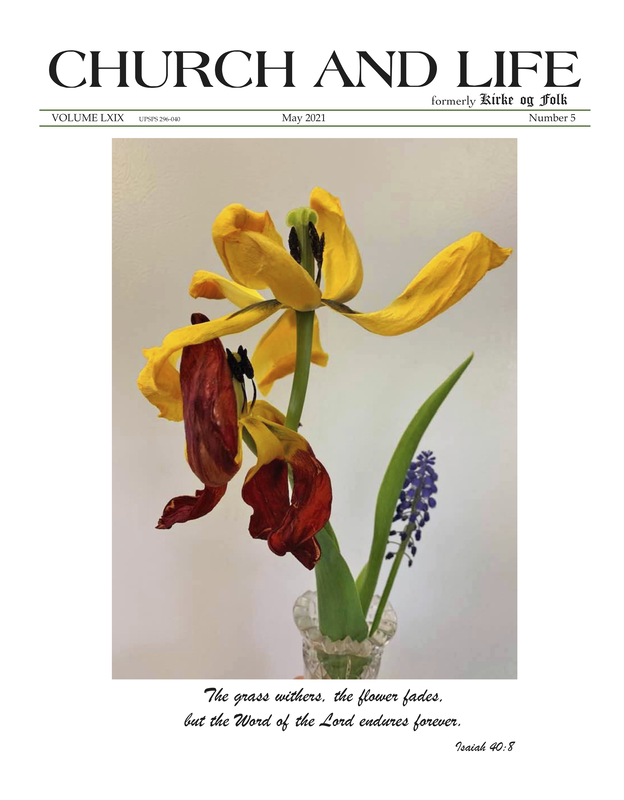
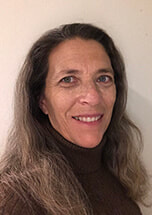
 RSS Feed
RSS Feed